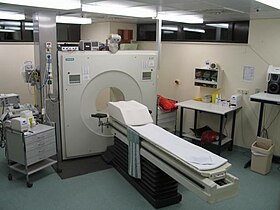Positron Emission Tomography
| Positron Emission Tomography | |
|---|---|
| Intervention | |

Image of a typical positron emission tomography (PET) facility
|
|
| ICD-10-PCS | C?3 |
| ICD-9-CM | 92.0-92.1 |
| MeSH | D049268 |
| OPS-301 code | 3-74 |
| MedlinePlus | 003827 |
Positron emission tomography (PET) is a nuclear medicine, functional imaging technique that is used to observe metabolic processes in the body. The system detects pairs of gamma rays emitted indirectly by a positron-emitting radionuclide (tracer), which is introduced into the body on a biologically active molecule. Three-dimensional images of tracer concentration within the body are then constructed by computer analysis. In modern PET-CT scanners, three dimensional imaging is often accomplished with the aid of a CT X-ray scan performed on the patient during the same session, in the same machine.
If the biologically active molecule chosen for PET is fludeoxyglucose (FDG), an analogue of glucose, the concentrations of tracer imaged will indicate tissue metabolic activity as it corresponds to the regional glucose uptake. Use of this tracer to explore the possibility of cancer metastasis (i.e., spreading to other sites) is the most common type of PET scan in standard medical care (90% of current scans). However, although on a minority basis, many other radioactive tracers are used in PET to image the tissue concentration of other types of molecules of interest. One of the disadvantages of PET scanners is their operating cost.
PET is both a medical and research tool. It is used heavily in clinical oncology (medical imaging of tumors and the search for metastases), and for clinical diagnosis of certain diffuse brain diseases such as those causing various types of dementias. PET is also an important research tool to map normal human brain and heart function, and support drug development.
PET is also used in pre-clinical studies using animals, where it allows repeated investigations into the same subjects. This is particularly valuable in cancer research, as it results in an increase in the statistical quality of the data (subjects can act as their own control) and substantially reduces the numbers of animals required for a given study.
...
Wikipedia
